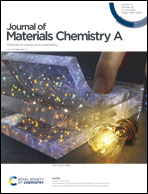The magnetohydrodynamic effect enables a dendrite-free Zn anode in alkaline electrolytes†
Abstract
Alkaline electrolyte based Zn batteries, relying on the redox reaction of Zn/ZnO (−1.35 V vs. SHE), offer a higher output voltage compared with neutral or mild electrolyte based Zn batteries (redox reaction of Zn/Zn2+, −0.76 V vs. SHE). However, the dendrite issue in alkaline electrolytes is also much exaggerated and leads to poor reversibility. To tackle the severe dendrite issue in alkaline electrolytes, a static magnetic field is introduced in this work to regulate the Zn deposition/dissolution behavior. A uniform Zn plating layer is obtained and validated by in situ optical microscopy. Surface roughness with a magnetic field (0.74 μm) is significantly reduced compared to that without a magnetic field (61.46 μm). COMSOL numerical simulation and electrochemical tests reveal that zincate ions can be subjected to the Lorentz force under a magnetic field, giving rise to micro-rotation and the magnetohydrodynamic (MHD) effect, which greatly alleviates the concentration polarization and enhances the mass transfer. Accordingly, the Zn symmetrical battery with alkaline electrolytes under a magnetic field can sustain up to a long cycle life of 260 h at 1 mA cm−2. Moreover, a Zn-air full battery with a magnetic field can keep working stably for 200 h at a high current density of 10 mA cm−2. The application of an external magnetic field in alkaline Zn batteries provides a practical and effective solution for addressing the Zn dendrite issue in alkaline electrolytes.



 Please wait while we load your content...
Please wait while we load your content...